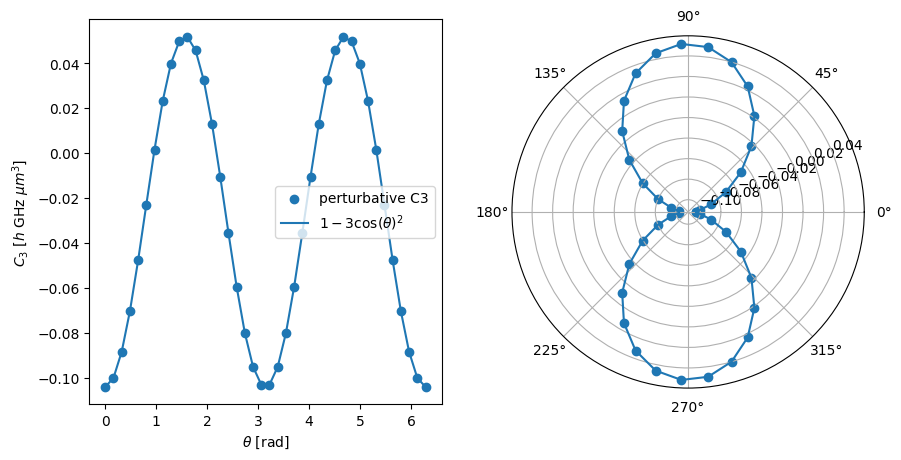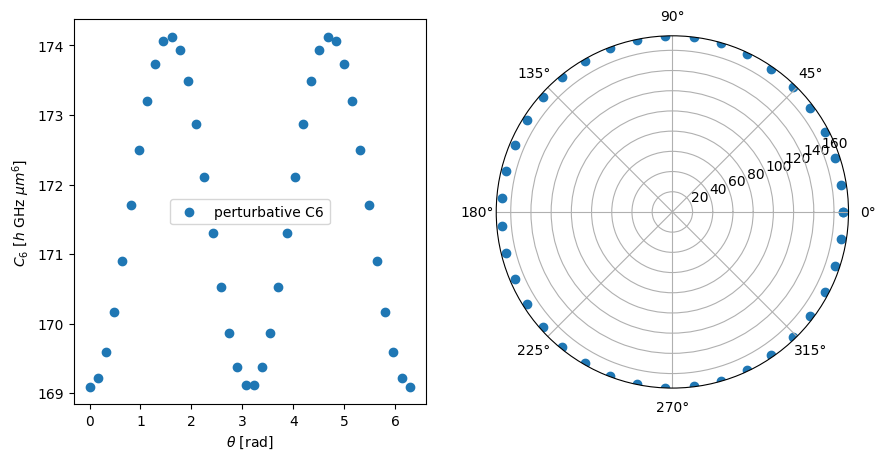\(C_3\) and \(C_6\) Coefficients
The PairInteraction Python API comes with high-level functionality to calculate \(C_3\) coefficients (dipole-dipole) and \(C_6\) coefficients (van der Waals) without having to write much code. All functionality for calculating the coefficients are provided by the pi.C3 and pi.C6 classes:
The constructor of the classes take the state of interest.
The
getmethod returns the coefficient.The classes determine automatically which states should be taken into account to obtain an accurate coefficient. To provide guidance how many states in the pair basis should be considered, you can use the method
set_minimum_number_of_ket_pairs.If the coefficient should be calculated in the presence of e.g. a magnetic field, the
set_magnetic_fieldmethod can be called before getting the coefficient. In general, the classes support similar setters as thepi.SystemAtomandpi.SystemPairclasses.
If you are interested in calculating effective Hamiltonians beyond just the \(C_3\) and \(C_6\) coefficients, also check out the tutorial Effective Hamiltonians.
[ ]:
%pip install -q matplotlib numpy pairinteraction
import matplotlib.pyplot as plt
import numpy as np
import pairinteraction as pi
if pi.Database.get_global_database() is None:
pi.Database.initialize_global_database(download_missing=True)
Quickly get a \(C_3\) and \(C_6\) coefficient
In the following, we have a minimal example for calculating a \(C_3\) and \(C_6\) coefficient.
[3]:
ket1 = pi.KetAtom("Rb", n=61, l=0, j=0.5, m=0.5)
ket2 = pi.KetAtom("Rb", n=62, l=1, j=1.5, m=0.5)
c3 = pi.C3(ket1, ket2).get("MHz um^3")
print(f"C3 coefficient between {ket1} and {ket2}: {c3:.3f} MHz um^3")
c6 = pi.C6(ket1, ket1).get("MHz um^6")
print(f"C6 coefficient of {ket1, ket1}: {c6:.3f} MHz um^6")
C3 coefficient between |Rb:61,S_1/2,1/2⟩ and |Rb:62,P_3/2,1/2⟩: -99.956 MHz um^3
C6 coefficient of (KetAtom(Rb:61,S_1/2,1/2), KetAtom(Rb:61,S_1/2,1/2)): 169208.742 MHz um^6
Angular dependence of the \(C_3\) and \(C_6\) coefficient
As a more sophisticated example, we calculate the angular dependence of the coefficients in the presence of a magnetic field along the quantization axis. For the angular dependence of the \(C_3\) coefficient, we recover the dipole pattern \(1-3\cos (\theta)^2\).
[ ]:
# Calculate C3 coefficients for different angles
c3_obj = pi.C3(ket1, ket2)
c3_obj.set_diamagnetism_enabled(False)
c3_obj.set_magnetic_field([0, 0, 20], "gauss")
thetas = np.linspace(0, 2 * np.pi, 40)
c3_coeffs = [c3_obj.set_angle(theta, unit="radian").get("GHz um^3") for theta in thetas]
# Plot the results
fig, axs = plt.subplots(1, 2, figsize=(10, 5))
axs[1].remove()
axs[1] = fig.add_subplot(1, 2, 2, projection="polar")
for ax in axs:
ax.scatter(thetas, c3_coeffs, label="perturbative C3")
ax.plot(
thetas,
-0.5 * c3_coeffs[0] * (1 - 3 * np.cos(thetas) ** 2),
label=r"$1-3\cos(\theta)^2$",
)
axs[0].legend()
axs[0].set_xlabel(r"$\theta$ [rad]")
axs[0].set_ylabel(r"$C_3$ [$h$ GHz $\mu m^3$]")
plt.show()

[ ]:
# Calculate C6 coefficients for different angles
c6_obj = pi.C6(ket1, ket1)
c6_obj.set_diamagnetism_enabled(False)
c6_obj.set_magnetic_field([0, 0, 20], "gauss")
c6_coeffs = [c6_obj.set_angle(theta, unit="radian").get("GHz um^6") for theta in thetas]
# Plot the results
fig, axs = plt.subplots(1, 2, figsize=(10, 5))
axs[1].remove()
axs[1] = fig.add_subplot(1, 2, 2, projection="polar")
for ax in axs:
ax.scatter(thetas, c6_coeffs, label="perturbative C6")
axs[0].legend()
axs[0].set_xlabel(r"$\theta$ [rad]")
axs[0].set_ylabel(r"$C_6$ [$h$ GHz $\mu m^6$]")
plt.show()
